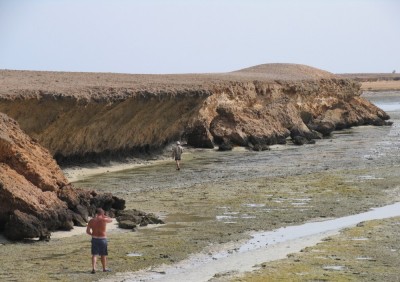New Publication on Radiocarbon Dating and Spatial Distribution of Farasan Shell Mounds

A new analysis of the spatial and temporal distribution of the Farasan shell mounds demonstrates major differences in rates of shell accumulation as a function of distance to the shoreline.
The paper Quantifying spatial variability in shell midden formation in the Farasan Islands, Saudi Arabia by Niklas Hausmann, Matthew Meredith-Williams, Katerina Douka, Robin Inglis and Geoff Bailey, has recently been published in PLOS One.
Over 3000 shell middens, or shell-matrix sites, have been recorded on the Farasan Islands and their distribution falls into one of two typical patterns. The first is a linear distribution of mounds that closely follows the shoreline, the other is a clustered distribution that includes mounds on the shoreline together with sites further inland at distances of tens of metres up to a kilometre distant from the original shoreline, referred to as 'post-shore' sites.
Analysis of 55 radiocarbon dates from 15 excavations that sample the range of variation in size and location demonstrates that the rate of accumulation of shells in shoreline sites is far greater than in the post-shore sites. This is consistent with ethnographic observations and energetic considerations that mass harvesting of molluscs results in removal of the shells as close as possible to the source of supply. Molluscs intended for consumption at post-shore sites either have the shells removed at processing sites on the shoreline before the meat is taken elsewhere for later consumption, or relatively few molluscs are taken inland while still in the shell. The shoreline sites are, thus, interpreted as specialist sites for the processing and consumption of shellfood, the post-shore sites as habitation sites situated further away from the shoreline for reasons of shelter or better access to other resources. Some of the shoreline sites could have been habitation sites if their location coincided with other attractions, and site location by itself is not a sufficient indicator of site function.
The full time range of the Farasan sites is ca. 7360 to 4600 cal BP and coincides with a period of sea-level rise to a mid-Holocene highstand of +2m at ca. 6000 cal BP followed by a regression to the present sea-level. Further analysis of the dates shows that only post-shore sites are present before 6000 cal BP, and that in consequence the bulk of recorded shell belongs to the period after 6000 cal BP. Taken at face value, this might suggest an intensification of shellfood collection after 6000. However, shoreline sites are, by definition, more vulnerable to destruction or submergence by sea-level rise or lateral erosion at the shore edge than post-shore sites. The absence of shoreline sites before 6000 could, then, be because the processing sites that were formed in the earlier period, and where most of the shell would have been deposited, have been removed by sea-level rise.
The paper explores the implications of these results for studies of shell middens in other parts of the world and especially from early Holocene or late Pleistocene periods, when the only sites likely to have survived above present sea-level are post-shore sites. Reliance on such sites for interpreting the palaeodietary role of shellfood or long-term trends in shellgathering is likely to be misleading, given that the palaeoshorelines and the shoreline sites where most of the shells would have been processed are now destroyed or submerged below present sea level.






